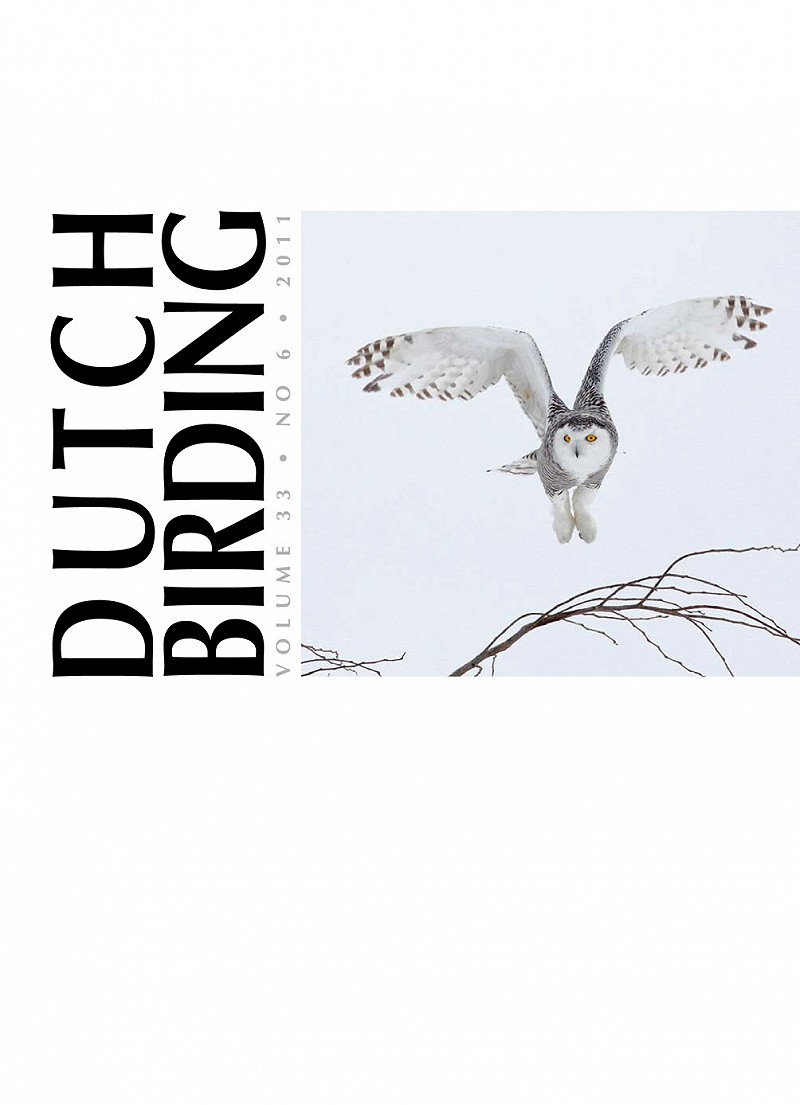Dutch Birding jaargang 33 nummer 6, 2011
CoverSnowy Owl · Bubo scandiacusChris van Rijswijk |
|
Artikelen / papers | |
| 357 - 376 |
Rare birds in the Netherlands in 2010
Arjan Ovaa, Dick Groenendijk, Max Berlijn & CDNA |
| 377 - 381 |
Eleonora’s Valk in Oostvaardersplassen in september 2011
Gilbert Rijmenans & Enno B Ebels Eleonora\'s Falcon at Oostvaardersplassen in September 2011On 17 September 2011, a group of c 50 birders from Belgium on a day trip to the Netherlands found and photographed a dark-morph Eleonora\'s Falcon Falco eleonorae at Oostvaardersplassen, Flevoland. The bird frequented an open forest area close to a large wetland area and roosted in dead trees. It was catching dragonflies on several occasions. The bird was watched from c 12:20 to 12:50 and last seen flying in a southerly or south-westerly direction; it was not seen by other observers. The next day, several 10s of birders searched the area, again without success. Based on the photographs, the bird was identified as a second-calendar year, mainly because of the blue-grey cere and orbital ring; the feet were yellow. The plumage was all dark with a brownish tinge. On the breast, a ghost pattern of breast streaking was visible. On the tertials and tail-feathers, dark brown barring was present. The underwing-coverts were black. Size and shape were comparable with a large and long-winged Eurasian Hobby F subbuteo. These characters only fit a second calendar-year Eleonora\'s and exclude pitfalls like Red-footed Falcon F vespertinus, dark-morph Eurasian Hobby, aberrant Common Kestrel F tinnunculus or Peregrine Falcon F peregrinus, or escaped falcons, including hybrids. Gilbert Rijmenans, Gelrodeweg 91, 3200 Aarschot, België |
| 382 - 385 |
Adult males Western Marsh Harrier with pale primary markings
Karel A Mauer |
Varia | |
| 386 - 393 |
Pacific albatrosses: Laysan, Short-tailed, Black-footed and Waved Albatross
Otto Plantema |
DBA nieuws | |
| 394 | Betaling van abonnementsgeld voor 2012; Payment of subscription for 2012 |
Corrigenda | |
| 394 |
Corrigenda
Redactie Dutch Birding |
WP reports | |
| 394 - 414 |
late September to early November 2011
Arnoud B van den Berg & Marcel Haas |
Recente meldingen / recent reports | |
| 415 - 428 |
september-oktober 2011
Roy Slaterus & Vincent van der Spek |
DB actueel | |
| 429 - 432 | Langstaartklauwier bij Den Helder [Long-tailed Shrike]; Hans ter Haar 1957-2011 |

